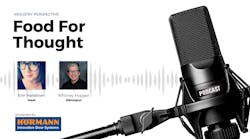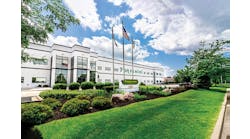Many in the production industry don’t realize the importance of high-quality doors to a facility’s success. In fact, high-performance doors can help your company save money and manpower — and increase productivity. This is especially true for those in the cold storage and food industries.
To explore the ins and outs of the high-performance door market and what doors might be best for your company, Food Processing sat down with Whitney Hopper, Director of Sales Cold Storage North America at Hörmann, to discuss.
Transcript
Food Processing: Can you explain how high-performance doors got their start in cold storage and food applications?
Whitney Hopper: Approximately 50 years ago in Europe, a leading conveyor belt manufacturer damaged one of their rolling steel doors. They decided to utilize belting material as the new door curtain. The concept worked well. The door was a lot faster, it saved them energy, and this new hybrid door system proved to be more durable and reliable than the rolling steel door. Thus, the concept for higher speed doors was developed.
High-performance doors entered the market with spiking costs of energy in Europe, driving demand for the new technology. Individual markets implementing the new high-performance doors include the cold storage and food sectors.
FP: What classifies a door as a high-performance door, and why would a facility use a high-performance door instead of a conventional sliding freezer door?
A subcategory of high-performance doors is high-speed doors. These are non-swing doors used primarily to facilitate vehicular access of material transportation. This type of door has automatic closing devices with a minimum operating rate of 32 inches per second and a minimum closing rate of 24 inches per second. High-performance doors are fast-moving and commonly used in a wide variety of commercial, industrial, cold storage and food applications. They're especially beneficial in the cold storage food industry because they assist in reducing energy cost and minimizing operating cost, and they can accommodate high cycles with minimal maintenance.
The historical problem with conventional sliding freezer doors is their limitations. They use antiquated technology and they're slow-moving, not very durable and very easily damaged. Further, they're expensive to repair, lose their seals, and, in most cases, require strip curtains. Ultimately, they’re just not very energy efficient, especially when a door cycles a lot in applications with cold temperatures. The energy loss from airflow is tremendous, and food safety is unnecessarily put at risk.
FP: How does a high-performance door contribute to production efficiencies in cold storage or food applications?
WH: High-performance doors used in cold storage and food applications save time. They save money, improve operational efficiencies and enhance safety due to their fast operating speeds and built-in safety features.
High-performance doors have also become a dynamic part of building design. They save energy and help to control the airflow in a building. Air exchange is often the most expensive part of total energy loss. High-performance doors contribute to the thermal efficiency of a building through dynamic thermal performance characteristics, especially important when a door cycles frequently.
High-performance doors are an excellent investment, and they provide a fast return on investment at a very low life cycle cost.
FP: Can you explain how return on investment, or ROI, would be determined for a specific application of high-performance doors?
WH: At first it might seem complex, but to calculate a return on investment using an energy analysis, a worksheet that follows the ASHRAE (American Society of Heating, Refrigerating and Air-Conditioning Engineers) formulas worksheet works well.
We start by doing a site visit to determine the criteria for evaluating the performance of their existing door or doors so that we can compare it to the performance of our new door or doors. We pick the right door for you by determining the following:
- Door opening width x height
- Average wind speed in the area
- Operating speeds of existing and proposed doors
- Type of energy loss
- Amount of time per day the door is open
- The forklift operator's loaded cost/hour
- The number of cycles per hour
- Air gaps around the existing door, the sides, the bottom and at the top
- The R-value of our door versus the R-value of the existing door
- The annual maintenance cost of the existing door
- Whether or not the new door is going to qualify for energy efficiency rebates from the local power company
You add this data together on a summary page to estimate your yearly and monthly cost savings.
FP: What are some of the renovation or new construction design trends you are seeing with your customers?
WH: A lot of the trends are focused on automation and conveyor systems to improve efficiency and reduce labor costs. I also see a lot of facilities that are being built with higher walls to reduce the building footprint and cut down on the cost of the real estate.
I’m also seeing greater numbers of companies incorporating air curtains or dryers with programmable controls and laser-based activation sensors, providing motion safety and presence detection. There is also new technology with the controls on the physical doors, including service support phone apps to diagnose issues, enabling diagnosis without the expense of an outside service technician coming in to determine what's wrong with the door. The door itself will tell you about the problem, and that's 24/7, 365 days a year diagnosing capability.
There are a lot of new trends out there, but those are the most common that I've seen in the past 12 to 24 months.



